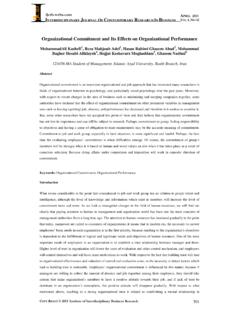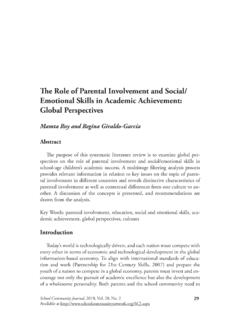Transcription of BRAIN-BASED LEARNING
1 +++++PLUS A BONUS CLASS PROJECT, RESOURCES, and a READING LISTBRAIN-BASEDLEARNINGSIX TIPS presentsforvisit UNDERSTANDING HOW THE brain WORKS, educators are better equipped to help students with everything from focusing attention to increasing retention. That s the promise of BRAIN-BASED LEARNING , which draws insights from neurology, psychology, technology, and other fields. Bringing this information to the classroom can help teachers engage diverse learners, offer effective feedback that leads to deeper understanding, and create a rich LEARNING environment that attends to students social and emotional needs along with their developing are, you already know more about BRAIN-BASED LEARNING than you think you do. When you introduce topics to your students, do you begin by activating prior knowledge? That helps learners build on what they already know, strengthening connections in the brain . Do you use tools like graphic organizers, songs, or rhymes?
2 These strategies help students represent their thinking visually, kinesthetically, and phonetically. These techniques all deserve a place in your tool kit because they get the brain primed for Kuhl, renown language and brain development researcher, puts it this way, We are embarking on a grand and golden age of knowledge about the child s brain development.. In investigating the child s brain , we are going to uncover deep truths about what it means to be human, and in the process, we may be able to help keep our own minds open to LEARNING for our entire lives. In this guide, you ll get practical tips across the K-12 spectrum, a reading list, and a variety of resources to help you learn more about this fascinating field. To help you and your students learn more about their own brainpower, we ve also included a bonus project that will get students thinking critically about promising as BRAIN-BASED discoveries may sound, some educators are understandably cautious about introducing lab findings in the classroom.
3 Anyone who remembers fallout over the so-called Mozart effect knows that there s no magic solution when it comes to education. As always, if a particular claim sounds too good to be true, that s a clue to trust your common sense and engage your own critical re eager to hear how you apply BRAIN-BASED LEARNING with your students. Please share your insights and help build the bridge from neuroscience research to engaging classroom practice. Suzie Boss Edutopia blogger and co-author of Reinventing Project- based LEARNING On Twitter @suzieboss TIPS AT A GLANCE1. Create a Safe Climate for LEARNING 2. Encourage a Growth Mind-set3. Emphasize Feedback4. Get Bodies and Brains in Gear5. Start Early6. Embrace the Power of NoveltyBONUS PROJECTB uild a brain Owner s Manual+ Recommended ReadingSix Tips for BRAIN-BASED LearningPlus, a bonus class project, resources, and a reading listLearn more: Watch a University of Minnesota video seminar on the impacts of stress on LEARNING : /workshops/videos/Stress Watch a lecture by Professor Claude M.
4 Steele on Identity and Stereotype Threat: Watch the Edutopia video An Introduction to Social and emotional LEARNING : Watch the previously recorded webinar Social and emotional LEARNING : Making a Case in an NCLB World : Eric Jensen, author of Teaching with Poverty in Mind, shares teaching tips in the post Why Teach Differently to Those from Poverty? #postcomment. Create a Safe Climate for LEARNING WHEN STUDENTS ARE FEELING ANXIOUS or fearful, they aren t in the mood to learn. That s because one part of the brain that processes emotions the amygdala responds to perceived threats by blocking information flow to the LEARNING centers of the brain . In layman s terms, stress scrambles the LEARNING circuits. To understand more about how the brain responds to stress, read the Edutopia article To Enable LEARNING , Put ( emotional ) Safety First ( ).Although educators can t overcome every stressor in a child s life, they can take practical steps to make the classroom environment more conducive to LEARNING .
5 Veteran teacher Linda Lantieri, author of Building emotional intelligence , recommends concrete strategies to help students stay calm and learn to manage their sometimes tumultuous emotions. As she explains in an Edutopia interview, The prefrontal cortex of the brain is the area for paying attention, calming, and focusing as well as the area for short- and long-term memory. So you need to focus in order to connect with your memory. Read more of her interview at meetings, developmental discipline, and student leadership teams are among the strategies that can foster healthy social and emotional LEARNING . Learn how a school district in Louisville, Kentucky, has implemented strategies to build students emotional health in this Schools That Work segment: environments that keep students highly engaged, that foster community and family connections, and that consider the needs of the whole child are the focus of a recent podcast by The Whole Child from ASCD.
6 For more ideas, listen to School Environments: Transforming LEARNING Spaces ( ).tip # SIX TIPS FOR BRAIN-BASED LEARNINGL earn more: Watch Dr. Norman Doidge's talk on brain plasticity: Listen to an interview on the growth mind-set with Carol Dweck: And listen to Dweck explain her research in a series of video segments: Diane Dahl is an elementary teacher who regularly applies BRAIN-BASED LEARNING strategies. Visit her blog to hear how she incorporates thinking about thinking into daily LEARNING activities, such as this les-son about having students model neural pathways: Encourage a Growth Mind-setASK STUDENTS TO DESCRIBE their brain with a metaphor and they re likely to suggest a computer, command center, or maybe a lightning-fast communications network. But they d be better off thinking of the brain as a muscle that gets stronger with use. Researchers now understand that IQ isn t fixed at birth. Just as we get more physically fit from exercising, we can build brainpower through the act of who adopt what psychologist Carol Dweck calls a growth mind-set understand that intelligence isn t fixed but can be developed through effort.
7 In Mindset, Dweck explains why students who have a growth mind-set are more willing to tackle challenges, learn from failure, and see criticism as useful feedback rather than a reason to give up. This is the kind of thinking that keeps students motivated, even when LEARNING is hard work. To learn how Dweck s research can improve the classroom environment, read Milton Chen s Edutopia post Smart Talking: Tell Students to Feed Their Brains ( ).The good news is that even mind-set isn t fixed. A growth mind-set can be learned and reinforced by messages that praise persistence and set high expectations. For example, help students understand that challenging assignments will stretch their thinking muscles. At the same time, provide them with necessary support so they don t get discouraged. (Edutopia blogger Rebecca Alber offers suggestions in Six Scaffolding Strategies to Use with Your Students : )Curious to learn more? In Mind, brain , and Education Science, a comprehensive guide based on more than 4,500 studies, Tracey Tokuhama-Espinosa presents five key concepts on the topic.
8 These concepts give us an accessible framework for talking about, and LEARNING about, BRAIN-BASED LEARNING : Human brains are as unique as faces. All brains are not equal because context and ability influence LEARNING . The brain is changed by experience. The brain is highly plastic. The brain connects new information to an excerpt from Tokuhama-Espinosa s book in New Horizons for LEARNING , a new journal from Johns Hopkins University School of Education ( ).Effective teaching strategies help students move toward higher-order thinking, or what neurologists call executive function. As neurologist turned teacher Judy Willis, MD explains, When you tip # SIX TIPS FOR BRAIN-BASED LEARNING (continued on next page)provide students with opportunities to apply LEARNING , especially through authentic, personally meaningful activities with formative assessments and corrective feedback throughout a unit, facts move from rote memory to become consolidated into related memory bank, instead of being pruned away from disuse.
9 Follow Willis s Edutopia posts to learn why, as she says, the neurons that fire together wire together ( ).Of course, all this brain activity is happening in a unique way for each student. By addressing learners individual needs, educators can help students strengthen the connections that will lead to deeper understanding. Experts David A. Sousa and Carol Ann Tomlinson team up to explain the science behind differentiated instruction in Differentiation and the brain : How Neuroscience Supports the Learner-Friendly Classroom. They suggest having faculty discussions about how teachers and administrators attitudes and behaviors (as well as school environments and procedures) can encourage or discourage a growth mind-set. Download their discussion Reproducibles: And for ideas about delivering differentiated instruction on a slim budget, see Edutopia s Schools That Work installment about a high-achieving elementary school in Tucson, Arizona: # SIX TIPS FOR BRAIN-BASED LEARNINGL earn more: Read Edutopia blogger Heather Wolpert-Gawron s practical post Tips for Grading and Giving Students Feedback : grading-tips-student-feedback-heather-wo lpert-gawron.
10 To help you maximize feedback opportunities during projects, download a copy of the Edutopia Classroom Guide Top Ten Tips for Assessing Project- based LEARNING : project- based - LEARNING - resource-guide. See a demonstration of peer feedback in the classroom in Edutopia s video on how to teach math as a social activity: Feedback EDUCATIONAL RESEARCHERS HAVE long stressed the value of feedback for keeping LEARNING on track. Savvy classroom teachers use a range of formative assessment strategies to check in on understanding and address misconceptions early. Not surprisingly, feedback is a cornerstone of BRAIN-BASED Mind, brain , and Education Science, Tokuhama-Espinosa points out, Great teachers know that moments of evaluation can and should always become moments of teaching. That means students need to know more than whether their answers were right or wrong. Understanding where and how they went wrong helps students adjust their thinking so they can improve.














